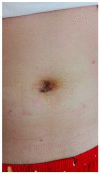Laparoendoscopic Single-Site Inguinal Herniorrhaphy: Experience of a Single Institute
- PMID: 36902571
- PMCID: PMC10003067
- DOI: 10.3390/jcm12051786
Laparoendoscopic Single-Site Inguinal Herniorrhaphy: Experience of a Single Institute
Abstract
Background: Minimally invasive techniques for inguinal herniorrhaphy have focused on developing the laparoendoscopic single-site (LESS) procedure to improve cosmesis. Outcomes of total extraperitoneal (TEP) herniorrhaphy vary considerably because of being performed by different surgeons. We aimed to evaluate the perioperative characteristics and outcomes of patients undergoing the LESS-TEP approach for inguinal herniorrhaphy and to determine its overall safety and effectiveness. Methods: Data of 233 patients who underwent 288 laparoendoscopic single-site total extraperitoneal approach (LESS-TEP) herniorrhaphies at Kaohsiung Chang Gung Memorial Hospital between January 2014 and July 2021 were reviewed retrospectively. We reviewed the experiences and results of LESS-TEP herniorrhaphy performed by a single surgeon (CHC) using homemade glove access and standard laparoscopic instruments with a 50 cm long 30° telescope. Results: Among 233 patients, 178 patients had unilateral hernias and 55 patients had bilateral hernias. About 32% (n = 57) of patients in the unilateral group and 29% (n = 16) of patients in the bilateral group were obese (body mass index ≥ 25). The mean operative time was 66 min for the unilateral group and 100 min for the bilateral group. Postoperative complications occurred in 27 (11%) cases, which were minor morbidities except for one mesh infection. Three (1.2%) cases were converted to open surgery. Comparison of the variables between obese and non-obese patients found no significant differences in operative times or postoperative complications. Conclusion: LESS-TEP herniorrhaphy is a safe and feasible operation with excellent cosmetic results and a low rate of complication, even in obese patients. Further large-scale prospective controlled studies and long-term analyses are needed to confirm these results.
Keywords: inguinal hernia; laparoendoscopic single-site surgery (LESS); total extraperitoneal approach (TEP).
Conflict of interest statement
The authors declare no conflict of interest.
Figures




Similar articles
-
A comparative study of standard versus laparoendoscopic single-site surgery (LESS) totally extraperitoneal (TEP) inguinal hernia repair.Surg Endosc. 2011 Sep;25(9):2879-83. doi: 10.1007/s00464-011-1636-y. Epub 2011 Jun 11. Surg Endosc. 2011. PMID: 21667210 Clinical Trial.
-
Comparison of single incision laparoscopic totally extraperitoneal and laparoscopic totally extraperitoneal inguinal hernia repair: initial experience.J Endourol. 2012 Jan;26(1):63-6. doi: 10.1089/end.2011.0352. Epub 2011 Oct 14. J Endourol. 2012. PMID: 21999423 Clinical Trial.
-
What happens after no contralateral exploration in total extraperitoneal (TEP) herniorrhaphy of clinical unilateral inguinal hernias?Hernia. 2018 Jun;22(3):533-540. doi: 10.1007/s10029-018-1752-x. Epub 2018 Feb 19. Hernia. 2018. PMID: 29460057
-
The role of the laparoendoscopic single site totally extraperitoneal approach to inguinal hernia repairs: a review and meta-analysis of the literature.Can J Surg. 2014 Apr;57(2):116-26. doi: 10.1503/cjs.010612. Can J Surg. 2014. PMID: 24666450 Free PMC article. Review.
-
Perioperative outcomes and complications of open vs laparoscopic extraperitoneal inguinal hernia repair in a mature surgical practice.Surg Endosc. 2004 Feb;18(2):221-7. doi: 10.1007/s00464-003-8934-y. Epub 2003 Nov 21. Surg Endosc. 2004. PMID: 14625733 Review.
Cited by
-
Is the recurrence rate higher in obese patients undergoing inguinal hernia surgery?Hernia. 2025 Feb 26;29(1):107. doi: 10.1007/s10029-025-03301-2. Hernia. 2025. PMID: 40000506
References
-
- Ielpo B., Nunez-Alfonsel J., Duran H., Diaz E., Fabra I., Caruso R., Malavé L., Ferri V., Barzola E., Quijano Y., et al. Cost-effectiveness of Randomized Study of Laparoscopic Versus Open Bilateral Inguinal Hernia Repair. Ann. Surg. 2018;268:725–730. doi: 10.1097/SLA.0000000000002894. - DOI - PubMed
LinkOut - more resources
Full Text Sources

